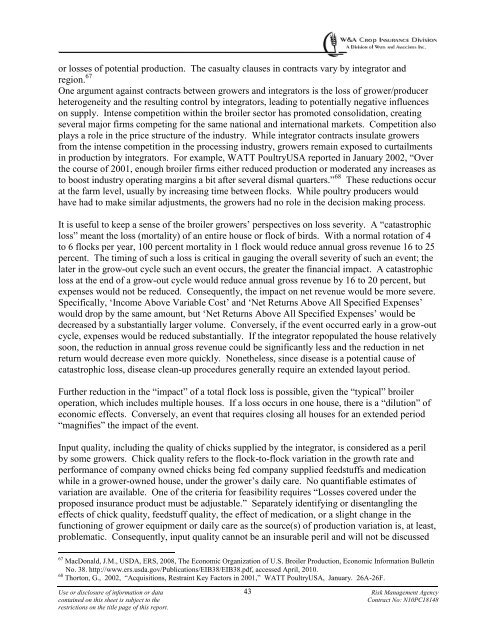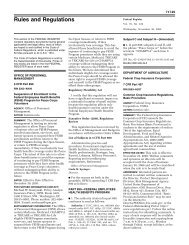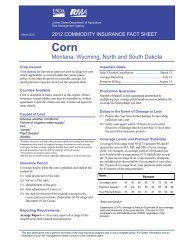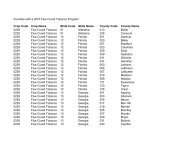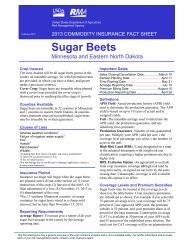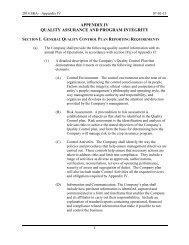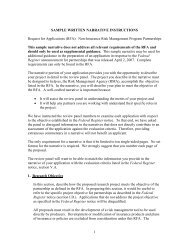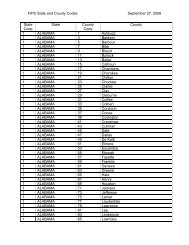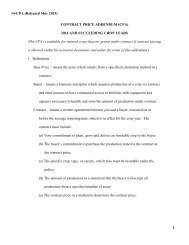Feasibility research report for insuring commercial poultry production
Feasibility research report for insuring commercial poultry production
Feasibility research report for insuring commercial poultry production
Create successful ePaper yourself
Turn your PDF publications into a flip-book with our unique Google optimized e-Paper software.
or losses of potential <strong>production</strong>. The casualty clauses in contracts vary by integrator andregion. 67One argument against contracts between growers and integrators is the loss of grower/producerheterogeneity and the resulting control by integrators, leading to potentially negative influenceson supply. Intense competition within the broiler sector has promoted consolidation, creatingseveral major firms competing <strong>for</strong> the same national and international markets. Competition alsoplays a role in the price structure of the industry. While integrator contracts insulate growersfrom the intense competition in the processing industry, growers remain exposed to curtailmentsin <strong>production</strong> by integrators. For example, WATT PoultryUSA <strong>report</strong>ed in January 2002, ―Overthe course of 2001, enough broiler firms either reduced <strong>production</strong> or moderated any increases asto boost industry operating margins a bit after several dismal quarters.‖ 68 These reductions occurat the farm level, usually by increasing time between flocks. While <strong>poultry</strong> producers wouldhave had to make similar adjustments, the growers had no role in the decision making process.It is useful to keep a sense of the broiler growers‘ perspectives on loss severity. A ―catastrophicloss‖ meant the loss (mortality) of an entire house or flock of birds. With a normal rotation of 4to 6 flocks per year, 100 percent mortality in 1 flock would reduce annual gross revenue 16 to 25percent. The timing of such a loss is critical in gauging the overall severity of such an event; thelater in the grow-out cycle such an event occurs, the greater the financial impact. A catastrophicloss at the end of a grow-out cycle would reduce annual gross revenue by 16 to 20 percent, butexpenses would not be reduced. Consequently, the impact on net revenue would be more severe.Specifically, ‗Income Above Variable Cost‘ and ‗Net Returns Above All Specified Expenses‘would drop by the same amount, but ‗Net Returns Above All Specified Expenses‘ would bedecreased by a substantially larger volume. Conversely, if the event occurred early in a grow-outcycle, expenses would be reduced substantially. If the integrator repopulated the house relativelysoon, the reduction in annual gross revenue could be significantly less and the reduction in netreturn would decrease even more quickly. Nonetheless, since disease is a potential cause ofcatastrophic loss, disease clean-up procedures generally require an extended layout period.Further reduction in the ―impact‖ of a total flock loss is possible, given the ―typical‖ broileroperation, which includes multiple houses. If a loss occurs in one house, there is a ―dilution‖ ofeconomic effects. Conversely, an event that requires closing all houses <strong>for</strong> an extended period―magnifies‖ the impact of the event.Input quality, including the quality of chicks supplied by the integrator, is considered as a perilby some growers. Chick quality refers to the flock-to-flock variation in the growth rate andper<strong>for</strong>mance of company owned chicks being fed company supplied feedstuffs and medicationwhile in a grower-owned house, under the grower‘s daily care. No quantifiable estimates ofvariation are available. One of the criteria <strong>for</strong> feasibility requires ―Losses covered under theproposed insurance product must be adjustable.‖ Separately identifying or disentangling theeffects of chick quality, feedstuff quality, the effect of medication, or a slight change in thefunctioning of grower equipment or daily care as the source(s) of <strong>production</strong> variation is, at least,problematic. Consequently, input quality cannot be an insurable peril and will not be discussed67 MacDonald, J.M., USDA, ERS, 2008, The Economic Organization of U.S. Broiler Production, Economic In<strong>for</strong>mation BulletinNo. 38. http://www.ers.usda.gov/Publications/EIB38/EIB38.pdf, accessed April, 2010.68 Thorton, G., 2002, ―Acquisitions, Restraint Key Factors in 2001,‖ WATT PoultryUSA, January. 26A-26F.Use or disclosure of in<strong>for</strong>mation or datacontained on this sheet is subject to therestrictions on the title page of this <strong>report</strong>.43Risk Management AgencyContract No: N10PC18148


